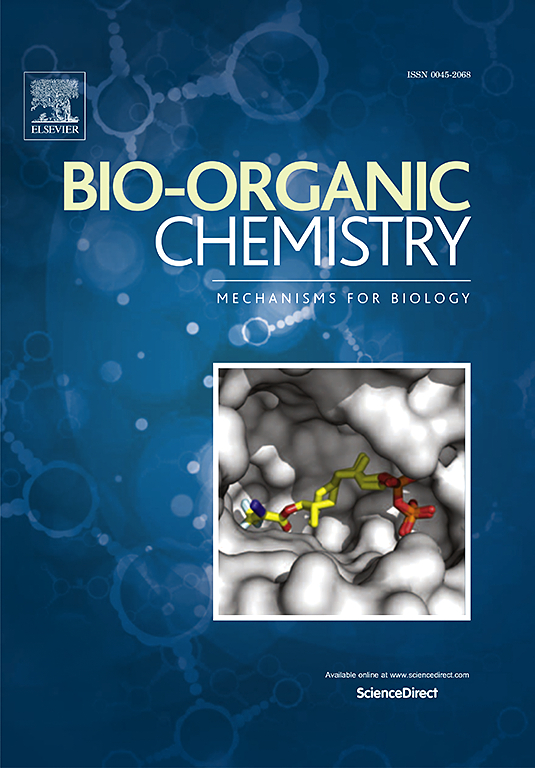pH-sensitive phthalocyanine-loaded polymeric nanoparticles as a novel treatment strategy for breast cancer
IF 4.5
2区 医学
Q1 BIOCHEMISTRY & MOLECULAR BIOLOGY
引用次数: 0
Abstract
Novel pH-sensitive polymeric photosensitizer carriers from the phthalocyanine (Pc) group were investigated as potential photodynamic therapy drugs for the treatment of breast cancer. Their high antiproliferative activity was confirmed by photocytotoxicity studies, which indicated their high efficacy and specificity toward the SK-BR-3 cell line. Importantly, the Pcs encapsulated in the polymeric nanoparticle (NP) carrier exhibited a much better penetration into the acidic environment of tumor cells than their free form. The investigated Pc4-NPs and TT1-NPs exhibited a high selectivity to healthy fibroblasts as well as non-toxicity without irradiation. This paper describes the detailed mechanism of action of the evaluated compounds by measuring reactive oxygen species (ROS), including singlet oxygen; imaging cellular localization; and analyzing key signaling pathway proteins. An additional advantage of the evaluated compounds is their ability to inhibit the Akt protein expression, including its phosphorylation, which the Western blot test confirmed. This is particularly important because breast cancers often overexpress the HER-2 receptor-related signaling proteins. Moreover, an analysis of proteins such as GLUT-1, HO-1, phospho-p42/44, and BID revealed the significant involvement of ROS in disrupting cellular homeostasis, thereby leading to the induction of oxidative stress and resulting in apoptotic cell death.

ph敏感酞菁负载聚合物纳米颗粒作为一种新的乳腺癌治疗策略。
研究人员将酞菁(Pc)类新型 pH 值敏感聚合物光敏剂载体作为治疗乳腺癌的潜在光动力疗法药物进行了研究。光细胞毒性研究证实了它们的高抗增殖活性,这表明它们对 SK-BR-3 细胞株具有很高的疗效和特异性。重要的是,封装在聚合物纳米粒子(NP)载体中的 Pcs 在肿瘤细胞酸性环境中的穿透力远远高于游离态。所研究的 Pc4-NPs 和 TT1-NPs 对健康的成纤维细胞具有高度的选择性,并且在无辐照的情况下无毒性。本文通过测量活性氧(ROS)(包括单线态氧)、细胞定位成像和分析关键信号通路蛋白,详细介绍了所评估化合物的作用机制。所评估化合物的另一个优点是能够抑制 Akt 蛋白的表达,包括其磷酸化,这一点已在 Western 印迹测试中得到证实。这一点尤为重要,因为乳腺癌通常会过度表达与 HER-2 受体相关的信号蛋白。此外,对 GLUT-1、HO-1、phospho-p42/44 和 BID 等蛋白质的分析表明,ROS 在很大程度上参与了细胞平衡的破坏,从而导致氧化应激的诱导和细胞凋亡。
本文章由计算机程序翻译,如有差异,请以英文原文为准。
求助全文
约1分钟内获得全文
求助全文
来源期刊

Bioorganic Chemistry
生物-生化与分子生物学
CiteScore
9.70
自引率
3.90%
发文量
679
审稿时长
31 days
期刊介绍:
Bioorganic Chemistry publishes research that addresses biological questions at the molecular level, using organic chemistry and principles of physical organic chemistry. The scope of the journal covers a range of topics at the organic chemistry-biology interface, including: enzyme catalysis, biotransformation and enzyme inhibition; nucleic acids chemistry; medicinal chemistry; natural product chemistry, natural product synthesis and natural product biosynthesis; antimicrobial agents; lipid and peptide chemistry; biophysical chemistry; biological probes; bio-orthogonal chemistry and biomimetic chemistry.
For manuscripts dealing with synthetic bioactive compounds, the Journal requires that the molecular target of the compounds described must be known, and must be demonstrated experimentally in the manuscript. For studies involving natural products, if the molecular target is unknown, some data beyond simple cell-based toxicity studies to provide insight into the mechanism of action is required. Studies supported by molecular docking are welcome, but must be supported by experimental data. The Journal does not consider manuscripts that are purely theoretical or computational in nature.
The Journal publishes regular articles, short communications and reviews. Reviews are normally invited by Editors or Editorial Board members. Authors of unsolicited reviews should first contact an Editor or Editorial Board member to determine whether the proposed article is within the scope of the Journal.
 求助内容:
求助内容: 应助结果提醒方式:
应助结果提醒方式:


